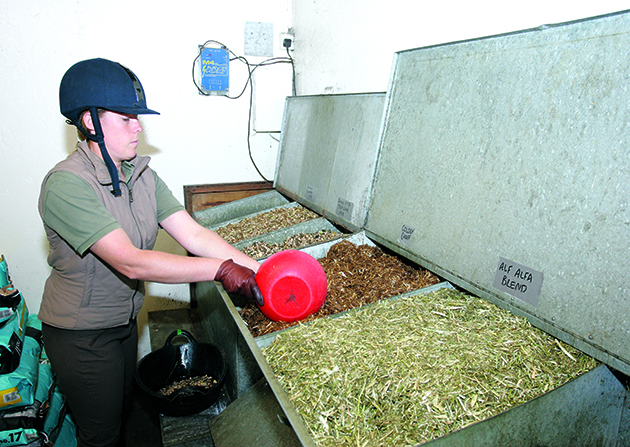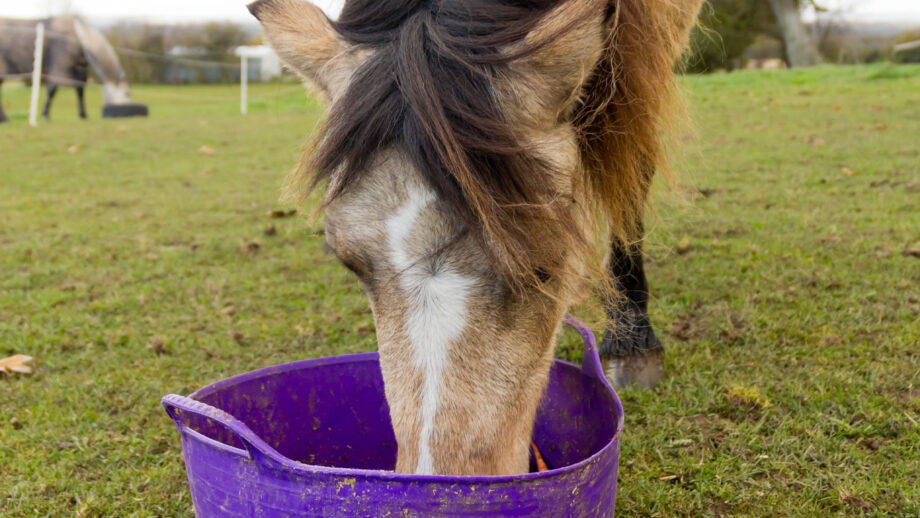How significant are hindgut issues? Tim Mair FRCVS discusses the horse’s engine: the large intestine
The horse is a hindgut fermenter, meaning that the large intestine is the site of digestion (fermentation) of ingested fibre. This is where food is converted into energy, which fuels bodily functions such as movement and helps the horse to maintain body heat.
The population of bacteria and other micro-organisms present in the hindgut is responsible for this fibre fermentation. Any major upset in this microbial community – termed dysbiosis – can result in “intestinal upsets”, causing diarrhoea, colic and weight loss.
Conditions affecting the large intestine, sometimes referred to as “hindgut issues”, are often a topic of debate. While scientific evidence regarding the prevalence and significance of certain problems may be lacking, many disorders in this section of the digestive tract are recognised and understood.
{"content":"PGgzPkJsb2NrZWQgcGlwZXM8L2gzPgo8cD5UaGUgaGluZGd1dCBjb21wcmlzZXMgdGhlIGNhZWN1bSwgbGFyZ2UgY29sb24sIHNtYWxsIGNvbG9uIGFuZCByZWN0dW0uIFRoZSBjYWVjdW0gaXMgYSBsYXJnZSwgYmxpbmQtZW5kZWQgc2FjIHRoYXQgb2NjdXBpZXMgbXVjaCBvZiB0aGUgcmlnaHQgc2lkZSBvZiB0aGUgaG9yc2XigJlzIGFiZG9tZW4gYW5kIGZ1bmN0aW9ucyBhcyBhIOKAnGZlcm1lbnRhdGlvbiB2YXTigJ0uIEhlcmUsIGZpYnJvdXMgZm9vZCBtYXRlcmlhbCBpcyBzdG9yZWQgYW5kIGZlcm1lbnRlZCBmb3Igc2V2ZXJhbCBkYXlzIGJlZm9yZSBwYXNzaW5nIGludG8gdGhlIGxhcmdlIGNvbG9uLjwvcD4KPHA+PGRpdiBjbGFzcz0iYWQtY29udGFpbmVyIGFkLWNvbnRhaW5lci0tbW9iaWxlIj48ZGl2IGlkPSJwb3N0LWlubGluZS0yIiBjbGFzcz0iaXBjLWFkdmVydCI+PC9kaXY+PC9kaXY+PHNlY3Rpb24gaWQ9ImVtYmVkX2NvZGUtMzEiIGNsYXNzPSJoaWRkZW4tbWQgaGlkZGVuLWxnIHMtY29udGFpbmVyIHN0aWNreS1hbmNob3IgaGlkZS13aWRnZXQtdGl0bGUgd2lkZ2V0X2VtYmVkX2NvZGUgcHJlbWl1bV9pbmxpbmVfMiI+PHNlY3Rpb24gY2xhc3M9InMtY29udGFpbmVyIGxpc3RpbmctLXNpbmdsZSBsaXN0aW5nLS1zaW5nbGUtc2hhcmV0aHJvdWdoIGltYWdlLWFzcGVjdC1sYW5kc2NhcGUgZGVmYXVsdCBzaGFyZXRocm91Z2gtYWQgc2hhcmV0aHJvdWdoLWFkLWhpZGRlbiI+DQogIDxkaXYgY2xhc3M9InMtY29udGFpbmVyX19pbm5lciI+DQogICAgPHVsPg0KICAgICAgPGxpIGlkPSJuYXRpdmUtY29udGVudC1tb2JpbGUiIGNsYXNzPSJsaXN0aW5nLWl0ZW0iPg0KICAgICAgPC9saT4NCiAgICA8L3VsPg0KICA8L2Rpdj4NCjwvc2VjdGlvbj48L3NlY3Rpb24+PC9wPgo8cD5JbXBhY3Rpb24gb2YgdGhlIGNhZWN1bSB3aXRoIGZlZWQgbWF0ZXJpYWwgY2FuIG9jY3VyIGluIG1hcmVzIGFmdGVyIGZvYWxpbmcgYW5kIGluIGhvcnNlcyB3aG8gYXJlIGhvc3BpdGFsaXNlZCBvciB1bmRlcmdvaW5nIHN1cmdlcnkgYW5kIHRyZWF0ZWQgd2l0aCBub25zdGVyb2lkYWwgYW50aS1pbmZsYW1tYXRvcnkgZHJ1Z3MuwqBTaWducyB0eXBpY2FsbHkgaW5jbHVkZSBsb3ctZ3JhZGUgY29saWMgYWxvbmcgd2l0aCBhIHJlZHVjdGlvbiBvciBjZXNzYXRpb24gb2YgdGhlIHF1YW50aXR5IG9mIGZhZWNlcyBiZWluZyBwYXNzZWQuPC9wPgo8cD5JZiBhbiBpbXBhY3Rpb24gaXMgbm90IHJlY29nbmlzZWQgb3IgdHJlYXRlZCwgcnVwdHVyZSBvZiB0aGUgY2FlY3VtIGNhbiBzb21ldGltZXMgb2NjdXIuIFNpbmNlIHRoaXMgaXMgdXN1YWxseSBmYXRhbCwgaXQgaXMgaW1wb3J0YW50IHRvIG1vbml0b3IgdGhlIHF1YW50aXR5IG9mIGZhZWNlcyBwYXNzZWQgYnkgdGhlc2UgYXQtcmlzayBob3JzZXMgYW5kIHRvIGZlZWQgdGhlbSBhIGxheGF0aXZlIGRpZXQgc3VjaCBhcyBicmFuIG1hc2hlcyBhbmQgZ3Jhc3MuPC9wPgo8cD5Gcm9tIHRoZSBjYWVjdW0sIGZvb2QgcGFzc2VzIGludG8gdGhlIGxhcmdlIGNvbG9uIOKAkyBhIHdpZGUsIHR1YnVsYXIgc3RydWN0dXJlIG1lYXN1cmluZyB1cCB0byAzLjcgbWV0cmVzIGluIGxlbmd0aC4gVGhlIGZ1bmN0aW9uIG9mIHRoZSBsYXJnZSBjb2xvbiBpcyB0byBjb250aW51ZSB0aGUgZmVybWVudGF0aW9uIGFuZCBkaWdlc3Rpb24gb2YgZmlicmUsIHByb2R1Y2luZyB2b2xhdGlsZSBmYXR0eSBhY2lkcyB3aGljaCBhcmUgdGhlbiBhYnNvcmJlZCBpbnRvIHRoZSBibG9vZHN0cmVhbSwgYW5kIHRvIGFic29yYiB3YXRlci48L3A+CjxkaXYgY2xhc3M9ImFkLWNvbnRhaW5lciBhZC1jb250YWluZXItLW1vYmlsZSI+PGRpdiBpZD0icG9zdC1pbmxpbmUtMyIgY2xhc3M9ImlwYy1hZHZlcnQiPjwvZGl2PjwvZGl2Pgo8cD5UaGUgbGFyZ2UgY29sb24gaGFzIGEgbnVtYmVyIG9mIFUtc2hhcGVkIGJlbmRzLCBvciBmbGV4dXJlcy4gSXRzIGNvbnZvbHV0ZWQgY291cnNlIGFuZCBhIHJlbGF0aXZlIGxhY2sgb2YgYW55IGFuY2hvcmluZyBsaWdhbWVudHMgbWFrZSBpdCBzdXNjZXB0aWJsZSB0byBkaXNwbGFjZW1lbnRzIGFuZCB0d2lzdHMsIHdoaWNoIGFyZSBjb21tb24gY2F1c2VzIG9mIGNvbGljLjwvcD4KPHA+SW1wYWN0aW9ucyBjYW4gYWxzbyBvY2N1ciBhdCB0aGUgZmxleHVyZSBzaXRlcyB3aGVyZSB0aGUgZGlhbWV0ZXIgb2YgdGhlIGNvbG9uIG5hcnJvd3MsIGVzcGVjaWFsbHkgdGhlIHBlbHZpYyBmbGV4dXJlLiBDb2xvbmljIGltcGFjdGlvbnMgYXJlIG1vc3QgY29tbW9ubHkgc2VlbiBpbiBob3JzZXMgdGhhdCBhcmUgc3VkZGVubHkgZXhwb3NlZCB0byBtYW5hZ2VtZW50IGNoYW5nZXMsIHN1Y2ggYXMgYWx0ZXJhdGlvbnMgdG8gZGlldCBvciBleGVyY2lzZS48L3A+CjxkaXYgY2xhc3M9ImFkLWNvbnRhaW5lciBhZC1jb250YWluZXItLW1vYmlsZSI+PGRpdiBpZD0icG9zdC1pbmxpbmUtNCIgY2xhc3M9ImlwYy1hZHZlcnQiPjwvZGl2PjwvZGl2Pgo8cD5DbGluaWNhbCBzaWducyBhcmUgc2ltaWxhciB0byB0aG9zZSBmb3IgY2FlY2FsIGltcGFjdGlvbnMuIFdoaWxlIGNvbG9uaWMgaW1wYWN0aW9ucyBhcmUgdXN1YWxseSBlYXNpZXIgdG8gdHJlYXQsIGl0IGNhbiBzdGlsbCBiZSBpbnRlbnNpdmUgYW5kIGNvc3RseSwgc28gcHJldmVudGlvbiDigJMgdGhhdCBpcywgZmVlZGluZyBhdC1yaXNrIGhvcnNlcyBhIGxheGF0aXZlIGRpZXQg4oCTIGlzIGFsd2F5cyB0aGUgZ29hbC48L3A+CjxoMz5UaGUgZmluYWwgcGhhc2U8L2gzPgo8cD5UaGUgc21hbGwgY29sb24gYW5kIHJlY3R1bSwgdGhlIGZpbmFsIHBhcnRzIG9mIHRoZSBoaW5kZ3V0LCBhcmUgaW52b2x2ZWQgd2l0aCBmdXJ0aGVyIGFic29ycHRpb24gb2Ygd2F0ZXIuIFRoaXMgaXMgd2hlcmUgZmFlY2FsIGJhbGxzIGFyZSBwcm9kdWNlZC48L3A+CjxkaXYgY2xhc3M9ImFkLWNvbnRhaW5lciBhZC1jb250YWluZXItLW1vYmlsZSI+PGRpdiBpZD0icG9zdC1pbmxpbmUtNSIgY2xhc3M9ImlwYy1hZHZlcnQiPjwvZGl2PjwvZGl2Pgo8cD5JbXBhY3Rpb25zIG9mIHRoZSBzbWFsbCBjb2xvbiBhbmQgcmVjdHVtIGNhbiBvY2N1ciBidXQgYXJlIGZvcnR1bmF0ZWx5IHJhcmUuIE1pbGQgZHlzZnVuY3Rpb24gb2YgdGhlIHNtYWxsIGNvbG9uIGNhbiBiZSBhc3NvY2lhdGVkIHdpdGggdGhlIHBhc3NhZ2Ugb2Yg4oCcZmFlY2FsIHdhdGVy4oCdLCB3aGVyZWJ5IGhvcnNlcyBwYXNzIG5vcm1hbCwgZm9ybWVkIGZhZWNhbCBiYWxscyBmb2xsb3dlZCBieSBhIHZvbHVtZSBvZiBtYWxvZG9yb3VzIGxpcXVpZC4gVGhlIHByZWNpc2UgY2F1c2UgaXMgb2Z0ZW4gdW5jZXJ0YWluLCBidXQgaXQgY2FuIGJlIGFzc29jaWF0ZWQgd2l0aCBhZ2UtcmVsYXRlZCBkYW1hZ2UgdG8gdGhlIHdhbGwgb2YgdGhlIHNtYWxsIGNvbG9uIGFuZCByZWN0dW0sIG9yIGR5c2Jpb3Npcy48L3A+CjxwPkNvbGl0aXMgaXMgZGVmaW5lZCBhcyBpbmZsYW1tYXRpb24gb2YgdGhlIGNvbG9uLiBTaW5jZSBvbmUgb2YgaXRzIG1ham9yIGZ1bmN0aW9ucyBpcyB0aGUgYWJzb3JwdGlvbiBvZiB3YXRlciwgZGFtYWdlIHRvIHRoZSB3YWxsIG9mIHRoZSBjb2xvbiBvZiB0aGUgYWR1bHQgaG9yc2UsIGNhdXNlZCBieSBpbmZsYW1tYXRpb24sIGZyZXF1ZW50bHkgcmVzdWx0cyBpbiBkaWFycmhvZWEuPC9wPgo8cD5UaGUgaGluZGd1dCBpcyBub3QgZnVsbHkgZGV2ZWxvcGVkIGluIGZvYWxzIGJlZm9yZSB3ZWFuaW5nOyBpbiB0aGlzIGFnZSBncm91cCwgZGlhcnJob2VhIGlzIG1vcmUgY29tbW9ubHkgZHVlIHRvIGluZmxhbW1hdGlvbiBvZiB0aGUgc21hbGwgaW50ZXN0aW5lIOKAkyB0ZXJtZWQgZW50ZXJpdGlzLjwvcD4KPHA+TWlsZCBkaWFycmhvZWEgY2FuIG9jY3VyIGZvciBtYW55IHJlYXNvbnMsIGluY2x1ZGluZyBhIGNoYW5nZSBvZiBkaWV0LCBzdHJlc3MgYW5kIGFjY2VzcyB0byBmcmVzaCBncmFzcy4gSW4gdGhlc2UgaW5zdGFuY2VzLCBpdCBpcyB1c3VhbGx5IHNlbGYtbGltaXRpbmcgYW5kIG9mIGxpdHRsZSBzaWduaWZpY2FuY2UuPC9wPgo8cD5PbiBvY2Nhc2lvbiwgaG93ZXZlciwgY29saXRpcyBjYW4gYmUgbGlmZS10aHJlYXRlbmluZy4gVGhlc2UgY2FzZXMgYXJlIG9mdGVuIGFzc29jaWF0ZWQgd2l0aCBvdmVyZ3Jvd3RoIGJ5IGNlcnRhaW4gc3BlY2llcyBvZiBiYWN0ZXJpYSwgc3VjaCBhcyBTYWxtb25lbGxhIGFuZCBDbG9zdHJpZGl1bSBzcGVjaWVzLCB3aGljaCBjYW4gaW52YWRlIGludG8gdGhlIGxpbmluZyBvZiB0aGUgY2FlY3VtIGFuZCBsYXJnZSBjb2xvbiwgYW5kIG1heSBwcm9kdWNlIHRveGlucyB0aGF0IGRhbWFnZSB0aGUgbGFyZ2UgaW50ZXN0aW5hbCB3YWxsLiBTb21lIG9mIHRoZXNlIGRpc2Vhc2VzIGNhbiBiZSBjb250YWdpb3VzIHRvIG90aGVyIGhvcnNlcyBhbmQgdG8gcGVvcGxlLjwvcD4KPHA+QW5vdGhlciBpbXBvcnRhbnQgY2F1c2Ugb2YgY29saXRpcyBpcyBsYXJ2YWwgY3lhdGhvc3RvbWlub3Npcywgd2hpY2ggb2NjdXJzIGR1ZSB0byBkYW1hZ2UgdG8gdGhlIGxhcmdlIGludGVzdGluZSBieSBtaWdyYXRpbmcgbGFydmFsIHN0YWdlcyBvZiB0aGUgc21hbGwgcmVkd29ybS4gU2V2ZXJlIGNvbGl0aXMgY2FuIGJlIGZhdGFsIHJhcGlkbHkgdW5sZXNzIGludGVuc2l2ZSB0cmVhdG1lbnQgaXMgaW5zdGl0dXRlZCBlYXJseTsgZm9yIHRoaXMgcmVhc29uLCBwcm9tcHQgdmV0ZXJpbmFyeSBhZHZpY2Ugc2hvdWxkIGJlIHNvdWdodCBmb3IgYW55IGhvcnNlIHdobyBkZXZlbG9wcyB3YXRlcnkgZGlhcnJob2VhLjwvcD4KPHA+TW9yZSBjaHJvbmljIGZvcm1zIG9mIGNvbGl0aXMgYWxzbyBvY2N1ciBzcG9yYWRpY2FsbHkuIFRoZXNlIGluZmxhbW1hdG9yeSBib3dlbCBkaXNlYXNlcyBhcmUgc2ltaWxhciBpbiBzb21lIHJlc3BlY3RzIHRvIHRob3NlIHNlZW4gaW4gaHVtYW5zLCBzdWNoIGFzIENyb2hu4oCZcyBkaXNlYXNlLiBJbiBob3JzZXMsIGhvd2V2ZXIsIHRoZXkgYXJlIG1vcmUgY29tbW9uIGluIHRoZSBzbWFsbCBpbnRlc3RpbmUgdGhhbiB0aGUgbGFyZ2UgaW50ZXN0aW5lIGFuZCBhcmUgdXN1YWxseSBhc3NvY2lhdGVkIHdpdGggcHJvZ3Jlc3NpdmUgd2VpZ2h0IGxvc3MuIElmIHRoZSBsYXJnZSBpbnRlc3RpbmUgaXMgaW52b2x2ZWQsIHRoZW4gY2hyb25pYyBkaWFycmhvZWEgZW5zdWVzLjwvcD4KPHA+U29tZSBpbmZsYW1tYXRvcnkgYm93ZWwgZGlzZWFzZXMgY2FuIHJlc3VsdCBpbiBpbmNyZWFzZWQgaW50ZXN0aW5hbCBwZXJtZWFiaWxpdHkuIEluIHRoZXNlIGNhc2VzLCB0aGUgdGVybSDigJxwcm90ZWluLWxvc2luZyBlbnRlcm9wYXRoeeKAnSBpcyBtb3JlIGFwcHJvcHJpYXRlIHRoYW4gdGhlIHBvb3JseSBkZWZpbmVkIGFuZCBjb250cm92ZXJzaWFsIOKAnGxlYWt5IGd1dCBzeW5kcm9tZeKAnSwgd2hpY2ggc3VnZ2VzdHMgdGhhdCB0aGUgbGluaW5nIG9mIHRoZSBpbnRlc3RpbmUgbGVha3MgcGxhc21hIHByb3RlaW5zIGR1ZSB0byBpbmZsYW1tYXRpb24gb3IgdWxjZXJhdGlvbi48L3A+CjxoMz5BcmUgdWxjZXJzIHRvIGJsYW1lPzwvaDM+CjxwPlVsY2VyYXRpb24gb2YgdGhlIHN0b21hY2gsIHRlcm1lZCBnYXN0cmljIHVsY2VyYXRpb24sIGlzIGEgY29tbW9uIGNvbmRpdGlvbiBpbiBwZXJmb3JtYW5jZSBob3JzZXMuIFRoZSBhc3NvY2lhdGVkIGNsaW5pY2FsIHNpZ25zIGNhbiBiZSB2YXJpZWQgYW5kIHZhZ3VlLiBBIGhvcnNlIG1heSBiZWNvbWUgcGlja3kgd2l0aCBzaG9ydCBmZWVkcywgZWF0aW5nIGEgbGl0dGxlIGFuZCB0aGVuIHdhbGtpbmcgYXdheS4gT3RoZXIgc2lnbnMgaW5jbHVkZSBncnVtcGluZXNzLCBsb3NzIG9mIHdlaWdodCBvciBjb2F0IGx1c3RyZSwgZGVjcmVhc2VkIGV4ZXJjaXNlIHRvbGVyYW5jZSBvciBwZXJmb3JtYW5jZSwgYW5kIHNlbnNpdGl2aXR5IHdoZW4gdGhlIGdpcnRoIGlzIHRpZ2h0ZW5lZCBvciB0aGUgYWJkb21lbiBicnVzaGVkLjwvcD4KPHA+RGlhZ25vc2lzIG9mIGdhc3RyaWMgdWxjZXJhdGlvbiBoYXMgYmVjb21lIGNvbW1vbnBsYWNlIHNpbmNlIHRoZSBpbnRyb2R1Y3Rpb24gb2YgZW5kb3Njb3Blcy4gQnV0IHdoYXQgYWJvdXQgdWxjZXJhdGlvbiBvZiB0aGUgc21hbGwgaW50ZXN0aW5lIG9yIGhpbmRndXQ\/IE1hbnkgcGVvcGxlIGJlbGlldmUgdGhhdCB1bGNlcmF0aW9uIG9mIHRoZSBoaW5kZ3V0IGNhbiBwcm9kdWNlIHN5bXB0b21zIHNpbWlsYXIgdG8gdGhvc2Ugb2YgZ2FzdHJpYyB1bGNlcmF0aW9uLCBidXQgdGhlcmUgaXMgY3VycmVudGx5IG5vIGVhc3kgd2F5IHRvIGRpYWdub3NlIHRoaXMgcHJvYmxlbSBpbiB0aGUgbGl2ZSBob3JzZS48L3A+CjxwPlJpZ2h0IGRvcnNhbCBjb2xpdGlzIGNhdXNlcyBzZXZlcmUgZGFtYWdlIHRvIGEgZGVmaW5lZCBhcmVhIG9mIHRoZSBsYXJnZSBjb2xvbiBhbmQgaXMgdXN1YWxseSBhc3NvY2lhdGVkIHdpdGggbG9uZy10ZXJtIGFkbWluaXN0cmF0aW9uIG9mIHBoZW55bGJ1dGF6b25lLiBUaGUgZGlhZ25vc2lzIG9mIHRoaXMgY29uZGl0aW9uIGlzIG9mdGVuIHVuY2VydGFpbiwgdW5sZXNzIGl0IGlzIGNvbmZpcm1lZCBieSBzdXJnaWNhbCBleHBsb3JhdGlvbiBhbmQgYmlvcHN5LjwvcD4KPGRpdiBjbGFzcz0iaW5qZWN0aW9uIj48L2Rpdj4KPHA+Q2xpbmljYWwgc2lnbnMgbWF5IHN1cHBvcnQgYSB0ZW50YXRpdmUgZGlhZ25vc2lzIGJ1dCwgb2YgY291cnNlLCB0aGUgcmVhbGl0eSBpcyB0aGF0IHVsY2VyYXRpb24gYW5kIGRhbWFnZSB0byBvdGhlciBhcmVhcyBvZiB0aGUgaGluZGd1dCBjb3VsZCBwcmVzZW50IHRoZSBzYW1lIHNpZ25zIOKAkyBpbmNsdWRpbmcgY29saWMsIHdlaWdodCBsb3NzLCBmYWVjYWwgY29uc2lzdGVuY3kgdmFyaWF0aW9uIGFuZCBpcnJlZ3VsYXIgYXBwZXRpdGUsIGFzIHdlbGwgYXMgYmVoYXZpb3VyYWwgaXNzdWVzIHJlbGF0aW5nIHRvIGNocm9uaWMgYWJkb21pbmFsIGRpc2NvbWZvcnQuPC9wPgo8cD48ZW0+UmVmOiBIb3JzZSAmYW1wOyBIb3VuZDsgMjYgTm92ZW1iZXIgMjAyMDwvZW0+PC9wPgo8cD4K"}
You may also be interested in:




